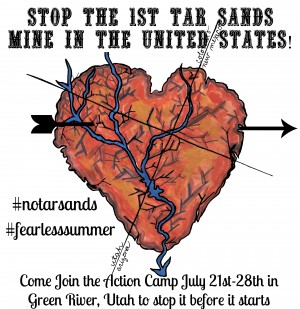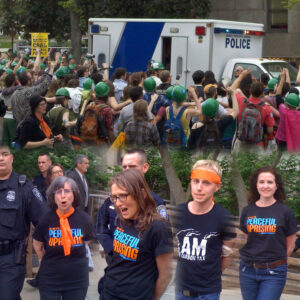This blog is cross-posted from Transition Lab, a grassroots education program which trains ordinary people to model, explore, and create a resilient future.

The #FearlessSummer action in our region is the #notarsands action camp (Learn more & sign up at beforeitstarts.org)
This week we got a lot of emails for events relating to the “Fearless Summer” of resistance to dirty energy. While the majority of our approach at Transition Lab is about creating alternatives to the Fossil Fuel economy, we also value the challenging work done by those on the frontlines of resistance. This week prompted discussions about the role and effectiveness of protest, and how a focus on mindfulness could empower the resistance through what we will call “empathic protest.”
The first thing we tried to do–which was remarkably easy–was to discern the qualities that resulted in an effective action compared to a counterproductive one. That quality was a sense of “otherness”. As soon as our hearts shut down in anger, we not only failed to connect with others, we actually witnessed a hardening of the hearts of our “opposition.” Conversely, in the few examples of successful actions that we could think of, this “otherness” simply wasn’t there.

Singing and smiling while being arrested? Yup. The feeling of connection with a street full of cheering supporters made it a natural response. (Read more about the Department of the Interior 21 arrests during Power Shift 2011.)
Sure, we may have been working to change something, but in the place where anger normally resides, we found only Joy and Resolve. We remembered singing at Tim DeChristopher’s trial or smiling while being arrested in front of the White House or at the Department of the Interior. The difference between a situation of otherness and one with connection is incredible.
What was harder to discern, though, was how to create sense of healthy togetherness when so much shit is going down. To the big question is how can we work with our heartbreak in skillful ways so that we can look back on these times and say, “There, that was different. That was the most difficult moment of my life, but it felt good.”
After hours of discussion, we realized that the same qualities that we verbalize at the end of each meditation were the same qualities that could create and support an effective political action. This dedication (taken from Russell’s experience at Naropa) reads:
“May we develop the bravery to commit to wakefulness, to bear witness to anguish, and to enjoy our lives.”
For us, developing, “the bravery to commit to wakefulness” means being honest with our our internal states, our perspectives, and what our motivating forces are. Having the courage to look inside our hearts to reveal if we are protesting because we are angry, or protesting because we love, may be the most difficult thing we do. As Martin Luther King, Jr. explained in his Letter from Birmingham Jail, “self-purification” and the internal cleansing of anger, selfishness and violent attitudes are integral preparation for a nonviolent struggle.

When we protest, where does our energy come from? How do we identify, label and treat those we protest against? We know that when resistance is centered in hostility and antagonism, it not only wears us down internally, it also invigorates the opposition and promotes defensiveness and further entrenchment in their opposing beliefs. It aggravates the tendency to “pick sides.”This isn’t just an observation we’ve all made- it’s neuroscience. Attacking others’ belief system is minimally effective… the brain deals with the cognitive dissonance by ignoring anything in conflict with core beliefs. In contrast, what can open people to new ideas is when they first feel respected, valued, and heard. In empathic protest, we resist the tendency to label as “other” those who disagree, and instead seek to understand them and their situation, then approach protest from their angle, with the bigger picture in mind. Taking this broader perspective, how would your approach to protest change?
Having the bravery “to bear witness to anguish” is inherently uncomfortable, but that’s where our greatest power comes from. There’s an unsettling force behind raw, exposed human heartbreak–the power to invoke deep, transformational empathy in others. As individuals, surrendering to our own heartbreak is frightening and unnerving, but in that breakdown we find the opportunity to leave behind old barriers, renew ourselves and approach life lighter and freer than before. Our culture teaches us that openly sharing such raw emotion is taboo, uncouth, and a sign of weakness. But in reality, it takes immense strength and bravery to expose our broken hearts in such a way as to provoke heartbreak in others. This is the core of empathic protest. Rather than pridefully antagonizing, we humbly expose painful reality to create human connection on a heart level, bypassing the mind and quickly reaching others where they can actually feel a transformation.
At the 2010 Mountain Film Festival, Russell and Jake both witnessed Chris Jordan create that powerful heart connection by bearing witness to the tragedy of the albatross in Midway. The albatross there instinctively collect food from the ocean to feed their chicks, but often what they think is food is actually garbage. Chris’ poignant work shows the carcasses of countless albatross chicks, stomachs packed with bits of plastic from the pacific gyre.
Those haunting images set the stage, but what really moved the audience was Chris’ candid, emotional exposure on stage afterward, sharing his deep grief, crying, and holding no pretense about how messed up this makes him feel. His presence left the audience feeling messed up as well, opening each individual up the transformative power of heartbreak and opening the door to new depths of empathy, compassion, and love. For more on this, we recommend reading these enlightening interviews:
- An Abiding Ocean of Love: A Conversation with Artist Chris Jordan | Center for Ecoliteracy
- Bearing Witness: Chris Jordan on Art, Grief, and Transformation by Brooke Jarvis | YES! Magazine.
Finally, we need “to enjoy our lives.” This seems simple enough, but the reality for many people is that it’s a daily struggle. In the context of the Fearless Summer, how can we infuse direct action with a genuine enjoyment of life? As it happens, the previous two sections support this. The first, wakefulness, is finding within yourself the space where you approach activism from a place of love. Second, bearing witness to anguish, can create space where folks feel safe in sharing their own grief, which will do wonders to tear down the walls between us. While the experience of shared grief is not itself enjoyable, the liberating aftermath and natural solidarity it builds amongst the group certainly is.
In Jake’s experience with Occupy Salt Lake, the greatest lasting good wasn’t from the marches, the strategic meetings or the protests, but from the sense of community and the blossoming of human connections which formed and last to this day. Make it a priority in activism to create spaces where people can naturally and casually meet, share, and connect. Finally, in the midst of actions, find ways to lighten up and promote an environment where people have fun. One of the most effective ways to do this is through music. Singing together is a powerful experience, and as Tim DeChristopher said “We will be a movement when we sing like a movement.” Bringing drums and a band to the streets is also fantastically energizing. Let’s build a movement which can be vibrant and silly, dress up, dance and play, make a scene and enjoy ourselves as an integral part of our resistance. And finally, we each must be willing ask if our work is really helping us to genuinely enjoy our lives, and find the strength to let go when we need to.
Many environmental and social justice leaders are expressing how we need to come up with a movement unlike any we’ve even imagined before, to address new challenges on a scale we’ve never seen before. However, when we imagine what this looks like, many times we only envision more protests, more people, more actions… more of the same. Maybe that will work, maybe not. At Transition Lab, we are convinced that the movement will change, but the secret ingredient will be heartbreak. If all the people who are on the streets now where practicing an Empathic Protest, it would be something unlike anything we’ve ever imagined, and in that: perhaps the chance that we will build a more resilient, conscious, meaningful and fun future.
Let’s go Team!
And one more thing. We really want this blog post to be a conversation amongst all of our friends in the movement. So put in your 2 cents, pass this on, and we look forward to hearing from you.
Leave a Reply